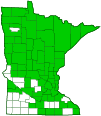four-spotted skimmer
(Libellula quadrimaculata)
Conservation • Description • Habitat • Ecology • Distribution • Taxonomy
|
|
||||||||||||
Description |
Four-spotted skimmer is an early season, medium-sized, 1⅝″to 1¾″ long skimmer. Males and females are similar in appearance. Juveniles and young adults are highly colorful and easily identifiable. The thorax and abdomen are densely covered with short hairs. The upper side of the thorax and abdominal segments 1 through 6 are bright yellowish-brown. Abdominal segments 7 through 10 are black. Each abdominal segment has two narrow yellow spots forming a continuous stripe on each side of the abdomen. The female’s abdomen is tapered like the male’s. The leading edge of each wing has a broad amber streak with yellow veins, a small black spot at the notch in the middle (nodus), and a dark stigma near the end. The base of each hindwing, where the wing attaches to the thorax, has a triangular black patch with yellow veins. The wings are otherwise clear. The forewing and hindwing triangles are a different size and shape. The face is yellow. The eyes are brown and meet at the top of the head. On mature individuals the yellowish-brown areas of the thorax and abdomen become dull grayish-brown and the wings lose most of their amber color. Eight-spotted skimmer has two large spots on each wing for a total of eight. Twelve-spotted skimmer has three large dark spots on each wing for a total of twelve. Four-spotted skimmer has two small dark spots on each wing and one large spot on each hindwing for a total of ten. A more appropriate name might be ten-spotted skimmer (Libellula decamaculata). |
Size |
Total length: 1⅝″to 1¾″ Wingspan: 3″ |
Similar Species |
Habitat |
Marshy or boggy lakes and ponds, fens, and slow streams. |
Ecology |
Season |
Mid-May to September |
Behavior |
Adults perch on the top of taller emergent vegetation, twigs, or weeds, often far from water. They launch from their perch to attack prey then return to the same perch. They sometimes forage in swarms over land or water. Males aggressively defend their territory. |
Life Cycle |
Mating takes place in flight and lasts from a few second to about a minute. With the male hovering nearby, the female deposits white eggs, one at a time, by dipping the tip of her abdomen in the water. The eggs soon turn brown and hatch in about five days, depending on water temperature. |
Naiad Food |
Aquatic insect larvae and tadpoles. |
Adult Food |
Mosquitoes, gnats, midges, and other dragonflies. |
Distribution |
||
|
Sources Haarstad, J. 1997. The dragonflies of selected eastern Minnesota rivers. Report submitted to the Minnesota Department of Natural Resources. Unpaged. Biodiversity occurrence data published by: Minnesota Biodiversity Atlas (accessed through the Minnesota Biodiversity Atlas Portal, bellatlas.umn.edu, 7/31/2025). |
|
| 7/31/2025 | ||
Occurrence |
||
Common and widespread |
||
Taxonomy |
|
Order |
Odonata (Dragonflies and Damselflies) |
Suborder |
|
Superfamily |
Libelluloidea |
Family |
Libellulidae (skimmers) |
Genus |
Libellula (king skimmers) |
Subordinate Taxa |
|
Leptetrum quadrimaculatum Leptetrum quadrimaculatum ssp. praenubilum Libellula basilinea Libellula contacta Libellula flavescens Libellula maculata Libellula praenubila Libellula quadrimaculata Libellula quadrimaculata ssp. asahinai Libellula quadrimaculata ssp. grigorievi Libellula quadrimaculata ssp. orientalis Libellula quadripunctata Libellula relicta Libellula ternaria |
|
Synonyms |
|
|
|
Common Names |
|
four-spotted chaser (Great Britain and Europe) four-spot pond skimmer four-spotted skimmer |
|
Glossary
Nodus
On dragonflies and damselflies: the small notch on the lead edge of each wing about halfway between the body and the tip.
Stigma
In plants, the portion of the female part of the flower that is receptive to pollen. In Lepidoptera, an area of specialized scent scales on the forewing of some skippers, hairstreaks, and moths. In other insects, a thickened, dark, or opaque cell on the leading edge of the wing.
Visitor Photos |
||
Share your photo of this insect. |
||
This button not working for you? |
||
Luciearl |
||
 |
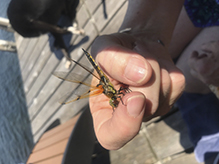 |
|
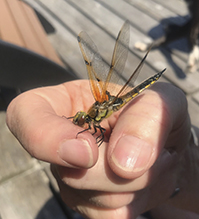 |
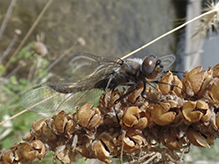 |
|
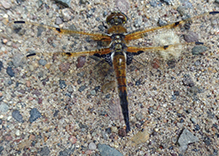 |
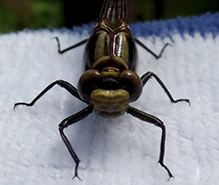 |
|
MinnesotaSeasons.com Photos |
||
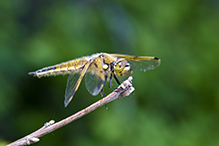 |
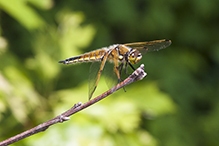 |
|
Juvenile or young adult |
Juvenile or young adult |
|
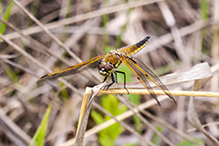 |
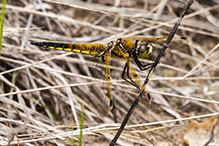 |
|
Juvenile or young adult |
Juvenile or young adult |
|
 |
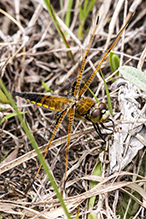 |
|
Juvenile or young adult |
||
|
||
|
||
|
Juvenile or young adult |
|
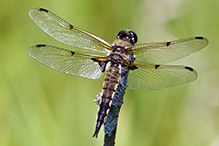 |
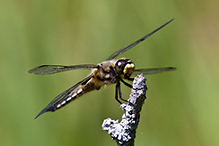 |
|
Mature adult |
Mature adult |
|
 |
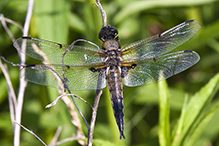 |
|
Mature adult |
||
|
||
|
||
Mature adult |
|

Slideshows |
Four Spotted Skimmer |
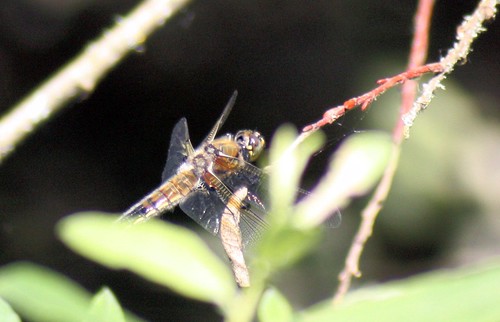
|
About
Copyright DianesDigitals |
Libellula quadrimaculata (Four-spotted Skimmer) |
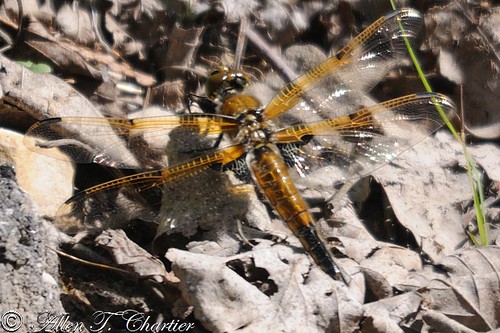
|
Libellula quadrimaculata-Emergència |
About
Uploaded on Dec 28, 2011 Libellula quadrimaculata-Emergència |

Visitor Videos |
||
Share your video of this insect. |
||
This button not working for you? |
||
|
Other Videos |
||
Schlupf einer Großlibelle- vermutlich Libellula quadrimaculata- big dragonfly |
About
Uploaded on May 9, 2009 Libellula quadrimaculata- Vierflecklibelle! beim Schlüpfen! Hier sieht man den Schlupf einer Großlibelle- vermutlich der Vierflecklibelle (Libellula quadrimaculata). Bildfolge aus 159 Bildern... Viel Spaß beim Anschauen!! Freue mich über Antworten... |
Viervlek Libelle (Libellula quadrimaculata) |
About
Published on May 31, 2012 Viervlek Libelle (Libellula quadrimaculata) - mei 2012 De viervlek (Libellula quadrimaculata) is een echte libel uit de familie van de korenbouten (Libellulidae). Gefilmd bij een ven in het Riels Laag (Riel, gemeente Goirle). Film: Martijn de Boer |
Four-spotted Skimmer (Libellulidae: Libellula quadrimaculata) |
About
Uploaded on Jun 12, 2011 Photographed at the Turtle River State Park, North Dakota (08 June 2011). |
Four-spotted Chaser | Libellula quadrimaculata |
About
Published on Jul 7, 2013 © DeadlyTeaParty Property ↆↆↆ CLICK DOWN FOR MORE! ↆↆↆ I was out in the building site that's behind our house ★ƬӇЄ ƲԼƬƖMƛƬЄ ƔƛƦƖЄƬƳ ƇӇƛƝƝЄԼ!!★ ➜Visit my ETSY if you want to buy some my photography and artwork! http://www.etsy.com/people/DeadlyTeaParty |
Four-spotted Chaser / Vierfleck (Libellula quadrimaculata) HD |
About
Published on Jun 11, 2012 Four-spotted Chaser / Vierfleck Filmed with Canon 600d and Tamron 70-300 VC USD. check out my photography-work here: Music by David Löhstana |

Visitor Sightings |
||
Report a sighting of this insect. |
||
This button not working for you? |
||
| Luciearl 6/6/2020 |
Location: Cass County |
 |
| Luciearl 6/27/2018 |
Location: Fairview Township |
 |
| Luciearl 6/8/2018 |
Location: Lake Shore, MN |
 |
MinnesotaSeasons.com Sightings |
||

Created: 6/30/2005 Last Updated: © MinnesotaSeasons.com. All rights reserved. |
